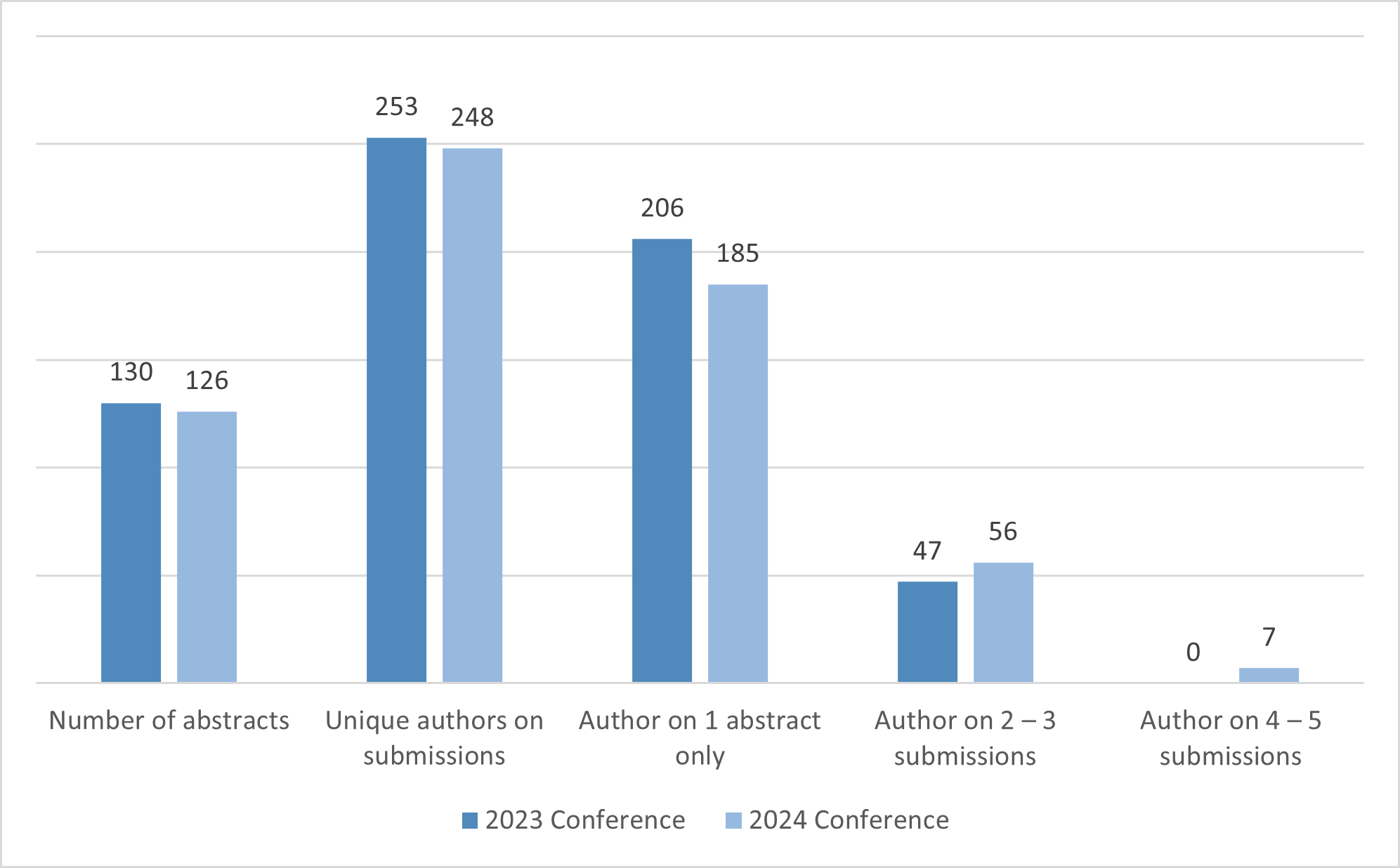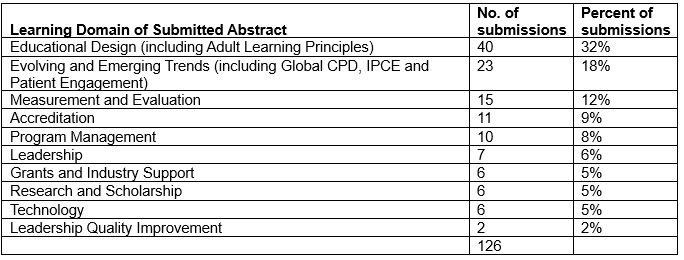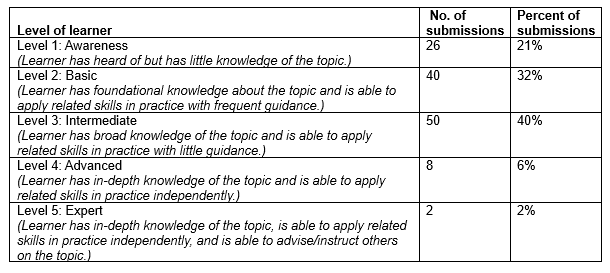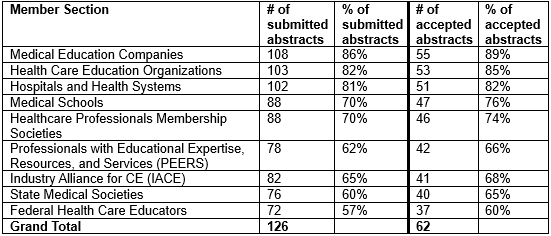

This article provides an in-depth analysis of the submitted and accepted abstracts for the Alliance 2024 Annual Conference, taking place in New Orleans, Feb. 5–8. This information can help you better understand the conference planning process, as well as how you may contribute to future meetings.
***
From an education perspective, we are a tough crowd. We are a group of education professionals who work in a variety of settings, from hospitals to associations, medical schools to industry. We are responsible for myriad jobs, such as content development, project management, grant writing, accreditation and educational outcomes, among many others. Some of us have formal training in adult learning, and others call ourselves “accidental educators,” coming from numerous backgrounds and evolving into adult learning roles. We are in challenging and meaningful careers, dedicated to the professionals we educate and charged with improving scientific research and clinical care.
For the Annual Conference Planning Committee, the work of building an annual meeting that meets the needs of all our learners requires careful and intentional educational design. Our chair, Chris Keenan, has been instrumental in creating a comprehensive “learning blueprint” for the three-day conference and for leading our Planning Committee to ensure the program is representative of the numerous needs and perspectives of the Alliance’s membership.
Recently, Chris wisely pointed out to me that ultimately, this conference is something that we build together, a program dependent on content submitted by our community. We decide what to teach and how best to teach it. We collaborate with each other to develop our ideas, which are reviewed by volunteers, who help the Planning Committee decide what the program will include. It is a house built for us, by us.
So how are we doing in building the house together? Are we submitting and presenting content that meets the needs of our community? Let’s take a look.
2024 Submissions
Abstract submissions for the 2024 conference were accepted from June 4 to July 14, 2023. During this time, 126 abstracts were submitted. For comparison, 130 abstracts were submitted for the 2023 conference, demonstrating relative consistency between the last two years for submissions.
Who submitted?
For the 2024 conference, there were 248 unique authors included in the submission for the 126 abstracts. The number of unique submitting authors was relatively consistent as compared to submissions for the 2023 conference, which saw 253 unique submitters on the 130 submitted abstracts. There was a notable difference in the number of submissions for each author. In 2023, 206 authors appeared on only one submission, with 47 being included on either two or three submissions. In 2024, 185 authors submitted only one abstract, with 56 authors were included on two or three abstracts, and the remaining seven authors being included on four or five abstracts. More authors in 2024 contributed to multiple session submissions, perhaps indicating an interest in a variety of topics.

Each abstract could include up to four authors; 105 of the 126 submitted abstracts included two or more authors, with roughly 30% including four authors. Since colleagues from the same organization might appear on a single abstract, this does not necessarily represent collaborations between different organizations. Yet, it does demonstrate a community which values providing a variety of perspectives within the sessions we plan.
In comparing submissions between 2023 and 2024 conference abstracts, 71% (175 of 248) of submitting authors had not submitted for the 2023 conference. While this sampling is limited to just the past two conferences, this does show an encouraging trend of the meeting attracting new individuals who wish to contribute their expertise to the conference.
Were the submissions representative of the Alliance’s Member Sections and of the larger CPD community?
The 2024 abstract submission authors represented 131 unique organizations, which were generally representative of all member sections within the Alliance membership. However, Medical Education Companies (MECs) submitted the highest number of submissions with Hospitals and Health Systems and Healthcare Education Organization Companies submitting the fewest. When considered in comparison with the Alliance membership and with the 2022 ACCME Annual Report, the proportion of submitting organizations from each Member Section may point to underrepresentation from certain types of organizations into the conference’s program. While there are limitations to these comparisons, it is interesting to consider how increasing submissions from certain member sections may help align the meeting’s content with the needs of the broader CE community.

* From 2022 ACCME Annual Report
** Combined ACCME Annual Report categories of government or military, nonprofit (other), other and insurance company/managed care company.
What was submitted?
At the time of submission, authors were asked to tag their abstracts with a variety of attributes, to allow the Planning Committee to ensure that 1) the overall program is applicable to all Alliance member sections and 2) that all areas of the Learning Blueprint are addressed.
Do the submissions cover the perceived needs of all Member Sections?
Submitters selected which member sections they felt would benefit from their sessions and could select as many groups as they wanted. All member sections were well represented.

Did the submissions cover all Learning Domains?
Submitters also selected a single Learning Domain for the submitted abstract. Perhaps not surprisingly, our community submitted the largest amount of content in the Educational Design Learning Domain.

Did the submissions address the needs of all levels of learners?
Submitters were also asked to identify the target level of experience for the learners for their sessions. Levels 4 and 5 were the least represented in the content, which may speak to authors’ assessment of the perceived needs of the target audience of the conference or perhaps a hesitancy of our authors to identify themselves as “expert faculty” in the topics they are interested in presenting.

Generally, each Learning Domain includes content designed for all learning levels. Perhaps not surprisingly, Level 5 submissions were only received in Evolving and Emerging Trends and Measurement and Evaluation, with each domain receiving one submission. Level 1 submissions were included in all Learning Domains. The majority of submissions were tagged as Levels 2–3 within each domain, with the exception of Leadership, which included 70% of submissions at Level 1.
Did the submissions align with the conference’s learning objectives? Did the community favor certain learning objectives over others?
The 2024 conference has been designed to address a variety of learning objectives; abstract submitters were asked to select at least one conference learning objective for their session. Over half of the submissions supported two or more conference learning objectives.

Were submitters interested in contributing their expertise in other ways?
Abstract submitters were also asked if they would be interested in having their content featured in other Alliance offerings. Some 79% of submissions identified an interest in presenting their content as an Alliance webinar and 59% as an Almanac article. Only 42% indicated an interest in presenting their session as a poster. This is potentially an area for further investigation by the Alliance, to better understand the reasons why authors were interested in one adjunctive format over another.
2024 Accepted Abstracts
Abstracts were reviewed by 73 reviewers, who rated abstracts on a variety of parameters, as well as the Conference Chair, Vice Chair, and Planning Committee.
Through the review process, 62 abstracts were accepted for presentation at the conference, representing a 49% approval rating. Generally, this acceptance rate was consistent amongst all Learning Domains; however, Leadership Quality Improvement and Measurement and Evaluation had higher than average acceptance rates while, Technology had a lower-than-average acceptance rate.

Similarly, the acceptance rate based on learner level (as identified by the abstract submitter) was 49%, though we did see higher rates of acceptance for sessions designed for Level 4 and Level 5 learners and a lower acceptance rate for Level 1 learners.

Applicability of the content for each Member Section remained proportionally consistent from what was submitted, with all Member Sections being represented in the approved program. It is worth noting that the proportion of content relevant to all member sections increased from what was submitted as compared to what was accepted, perhaps indicating that abstracts with broader applicability were more likely to be accepted. However, this was not an explicit criterion during the review process.

Key Insights
Reflecting on these data, a few things become apparent:
- The content submitted by our community addressed all the conference learning objectives and is perceived by submitters to be applicable to all Alliance Member Sections.
- The submissions favored the needs of intermediate learners over those of novice or expert learners.
- Certain types of organizations were more actively engaged in suggesting ideas for the conference via the abstract submission process and, as compared to the larger CPD community, may not be fully representative of the work of many organizations.
- Submissions reflected a high level of collaboration and appeared to encourage new individuals to become engaged.
- The accepted abstracts were proportionally consistent with the submissions, pointing to a program which is reflective of the community’s interests and expertise.
- Overall, the accepted program addresses the varying needs of our learners with regards to Learning Domain, Level of Learner and applicability to each Member Section. However, there are areas for potential improvement to ensure we, as a community, continue to meet the needs of all learners.
Looking Forward: 2025 and Beyond
Associations are often seen as the “educational home” for members, and the Alliance is no different. We are a group that understands the power of education and how to build it. And while we may be a tough crowd, we are also a group that is committed to sharing our expertise with each other. My hope is that this information will provide insights into the process used to develop the Annual Conference Program as well as how we, as a community, give back to each other through our volunteerism at the conference. We have a lot of different perspectives and areas of expertise. I encourage all of us to consider what we can contribute to the conference and how our unique voice can be of benefit to all.
Do you have an idea worth sharing or something you want to explore? Abstract submissions for the Alliance 2025 Annual Conference will open in early March. Let’s continue building something great — together.
Thanks to Jas Chahal, Kenny Cox, Chris Keenan, Pam McFadden and Alliance staff, April Cheverette, Danielle Callen and Morgan Manghera, for their assistance in the development and publication of this article.